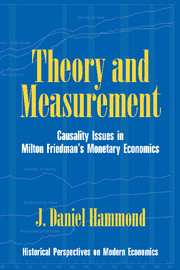Book contents
- Frontmatter
- Contents
- Acknowledgments
- Introduction
- 1 Theory and Measurement at the National Bureau
- 2 Origins of Friedman's Marshallian Methodology
- 3 Origins of the Monetary Project
- 4 Critiques from Within the National Bureau
- 5 Post Hoc Ergo Propter Hoc: Part I
- 6 Reactions to the Monetary History
- 7 Post Hoc Ergo Propter Hoc: Part II
- 8 Friedman and His Critics on the Theoretical Framework
- 9 The Great Depression
- 10 Measurement without Measurement: Hendry and Ericsson's Critique
- Conclusion
- Appendix
- Bibliography
- Index
1 - Theory and Measurement at the National Bureau
Published online by Cambridge University Press: 16 September 2009
- Frontmatter
- Contents
- Acknowledgments
- Introduction
- 1 Theory and Measurement at the National Bureau
- 2 Origins of Friedman's Marshallian Methodology
- 3 Origins of the Monetary Project
- 4 Critiques from Within the National Bureau
- 5 Post Hoc Ergo Propter Hoc: Part I
- 6 Reactions to the Monetary History
- 7 Post Hoc Ergo Propter Hoc: Part II
- 8 Friedman and His Critics on the Theoretical Framework
- 9 The Great Depression
- 10 Measurement without Measurement: Hendry and Ericsson's Critique
- Conclusion
- Appendix
- Bibliography
- Index
Summary
Introduction
“Measurement Without Theory” was the title that Tjalling Koopmans gave his famous review of Arthur Burns and Wesley Mitchell's Measuring Business Cycles. That phrase seemed to sum up the differences between the ascendant Cowles Commission approach and the National Bureau of Economic Research (NBER) approach to macroeconomic, or business-cycle, analysis in 1947. Whereas both organizations shared a concern for understanding business-cycle phenomena in order to provide a basis for control, their means to this end differed markedly. The Cowles Commission objective was to wed neoclassical economic theory and modern probabilistically based econometrics. They were actually creating what came to be recognized as modern econometrics, their emphasis was on theory. The National Bureau objective, as Koopmans indicated, had much more to do with measurement. A large portion of the effort at the National Bureau went toward developing measurement concepts such as national income accounts and the “reference cycle,” along with their related data series. National Bureau analysis of business cycles consisted of separating trends and cycles in time series, and relating patterns in cycles across different series. Burns and Mitchell's book epitomized for Koopmans the National Bureau's atheoretic approach and its fruitlessness for understanding business-cycle phenomena.
Koopmans was neither the first nor the last critic to bring the charge of “measurement without theory” against the National Bureau. The question of the relationship between the work done there under Mitchell's leadership and neoclassical economic theory was an old one.
- Type
- Chapter
- Information
- Theory and MeasurementCausality Issues in Milton Friedman's Monetary Economics, pp. 5 - 25Publisher: Cambridge University PressPrint publication year: 1996
- 1
- Cited by

